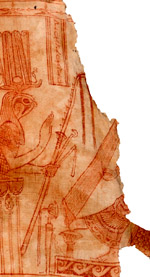These essays present the results of a workshop that took place on 24 November 2017 at the Centre for Textile Research (CTR), University of Copenhagen. The event was organised within the framework of the MONTEX project—a Marie Skłodowska-Curie individual fellowship conducted by Maria Mossakowska-Gaubert in collaboration with the Contextes et Mobiliers programme of the French Institute for Oriental Archaeology in Cairo (IFAO), and with support from the Institut français du Danemark and the Alexander von Humboldt Foundation. Twelve essays are arranged in 4 sections: I. Weaving looms: texts, images, remains; II. Technology of weaving: study cases; III. Dyeing: terminology and technology; IV. Textile production in written sources: organisation and economy.
Contributors include: Maria Mossakowska-Gaubert, Johanna Sigl, Fleur Letellier-Willemin, Lise Bender Jørgensen, Anne Kwaspen, Barbara Köstner, Peder Flemestad, Ines Bogensperger & Helga Rösel-Mautendorfer, Isabelle Marthot-Santaniello, Aikaterini Koroli, Kerstin Dross-Krüpe, Jennifer Cromwell, and Dominique Cardon. Essays include 66 full-colour illustrations.
Volume published by Zea Books, Lincoln, Nebraska
2020
Frontmatter for Egyptian textiles and their production: ‘word’ and ‘object’. (Hellenistic, Roman and Byzantine periods), Maria Mossakowska-GaubertA new kind of loom in early Roman Egypt? How iconography could explain (or not) papyrological evidence, Maria Mossakowska-GaubertEgyptian pit-looms from the late first millennium AD — attempts in reconstruction from the archaeological evidence, Johanna SiglTackling the technical history of the textiles of El-Deir, Kharga Oasis, the Western Desert of Egypt, Fleur Letellier-WilleminTextiles from a Late Roman/Byzantine ecclesiastical centre at Abu Sha’ar, Egypt, Lise Bender JørgensenReconstruction of a deconstructed tunic, Anne KwaspenWhat flaws can tell: a case study on weaving faults in Late Roman and Early Medieval weft-faced compound fabrics from Egypt, Barbara KöstnerAncient Greek dyeing: a terminological approach, Peder FlemestadDyeing in texts and textiles: words expressing ancient technology, Ines Bogensperger and Helgo Rösel-MautendorferFlax growing in late antique Egypt: evidence from the Aphrodito papyri, Isabelle Marthot-SantanielloTextile production in the papyri: the case of private request letters, Aikaterini KoroliHow (not) to organise Roman textile production. Some considerations on merchant-entrepreneurs in Roman Egypt and the ἱστωνάρχης, Kerstin Droß-KrüpeDomestic Textile Production in Dakhleh Oasis in the Fourth Century AD, Jennifer CromwellConclusion: Egyptian Textiles and Their Production, Dominique Cardon










 Stumble It!
Stumble It!

No comments:
Post a Comment